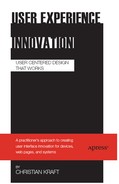Step 2: Identify Your Potential Ecosystem
The first thing you want to do is to identify your ecosystem. This step is not only about identifying your current ecosystem, but very much also about identifying your potential ecosystem.
If you are designing a social website, you may want to look at how to integrate features from (maybe competing) social websites, from weather forecast providers, from existing online calendar applications, and so forth. You may want to look at providing dedicated PC or mobile device applications that may improve or extend the experience of your website.
If you are designing a remote control device, you will need to look at potential accompanying PC software for setting up the remote control and potential Internet services to help the user out. For example, if your remote control is for a TV, you might want to design onscreen menus that allow the user to personalize the remote control.
If you are designing a mobile device, you will need to look at the entire ecosystem involving how the user downloads new applications to the device; how the user edits, backs up, and shares contacts via a PC or the Internet; and so forth.
If you are designing a piece of PC software, you will need to look at how integration with your Internet-based services (e.g., templates, settings, and similar) can easily be applied. You will also need to look at applying your PC software to specific physical devices, such as mobile phones. And you will need to look at how you can potentially integrate your solutions with other PC software.
I have deliberately avoided using the phrase thinking outside the box previously in this book, since that term has been misused to cover so many different things. But in this case you really need to think outside of the box. And in this case your box is the specific product—or sometimes even part of the product—that you are designing. And outside of the box can refer to many things—from obvious ecosystem elements to the fridge in the user's kitchen. You need to see your device, system, or web page from a much bigger perspective.
You need to be very open-minded when thinking about your potential ecosystem, but you also need to restrict yourself. Potentially any product in this world could communicate with a fridge, a coffee machine, or an Internet service, but you need to keep your focus on the relevant ecosystem elements.
A good general approach to identifying and prioritizing your ecosystem elements is to invite a group of people for a meeting specifically to identify those elements. As always, you should also invite users to this session, and in this case lead users would be an obvious choice, since these users may be able to think outside of the box for your product.
Following, I will go through concrete approaches to identifying and prioritizing your ecosystem elements.
User Needs for Identifying Ecosystem Elements
To identify the relevant ecosystem elements you should use the user needs of your target users. User needs will often reveal potential and uncovered ecosystem elements of your product.
If you are designing an Internet tablet, the user needs may, for example, reveal the need for easily downloading or streaming music. And you should hence include music download and music streaming to your ecosystem. If you are designing a piece of word-processing software, user needs may reveal that the users have a need to perform spreadsheet functions, and you would hence add spreadsheet applications to your ecosystem. And so forth.
In the example of an e-book reader application, the user needs include the ability to get a new book when finished with the last book, and hence book publishers for e-books should be added to the ecosystem. Actual authors of novels, literature, poems, and so on would also be added.
Another need for the target users of the e-book reader is the ability to read a book even when commuting to and from work. Hence adding mobile devices to the ecosystem is natural.
A third user need identified for the e-book reader is that users would love to have their reading experience enhanced—for example, with music and background images. This means that music providers and image providers are added to the ecosystem.
Core Tasks for Identifying Ecosystem Elements
Also, the core tasks can help you identify and prioritize your ecosystem. If the user has several core tasks that are poorly covered or not covered by your product, then these are very important ecosystem elements.
If you are designing a smart phone, you may find out that downloading a new application to the device is a core task. So you should add application providers and probably also application developers to your ecosystem. If you are designing a video conversion application for PCs, you may find out that burning a DVD disc is a core task, and if your software does not already support this, you will want to add it to your ecosystem.
In the case of the e-book reader application, one of the identified core tasks is printing the book. Hence printers are added to the ecosystem.
Pain Points for Identifying Ecosystem Elements
Finally, pain points often reveal elements of your ecosystem, especially those elements where the current solutions are not good enough.
If you are designing a mobile device, you might identify a pain point around connecting to the Internet, and you will hence include the network operators' handling of Internet connections as part of the ecosystem. If you are designing an LCD TV, and users report that setting up the channels is a hurdle, then you might decide that a PC interface and application should be part of your ecosystem. If the TV is able to connect to the Internet, you could also add web services to your ecosystem.
With the e-book reader example, it has been identified that the fonts used for displaying the text are hard to read. Hence font providers are added to the ecosystem.
